
Physics of Energy & the Environment- PHYS 161
Lecture 3
Reading: Chapter 3, pages 29-41. Chapter 20, pages 467-476.
Homework 1 is due this lecture.
 Review of Newton's Second Law.
Review of Newton's Second Law.
 Displacement, velocity, acceleration, force and mass in words.
Displacement, velocity, acceleration, force and mass in words.

 Review of Newton's Second Law
Review of Newton's Second Law
- Assumption: The net force acting on the cart is equal to the force of the fan on the fan cart. We are neglecting any frictional forces (and air resistance) for now.
- Hypothesis I: acceleration is proportional to total force (for constant mass).
- Experiment I: We tested this hypothesis by varying the net force on the cart (more or less batteries powering the fan) and observing its acceleration while keeping the mass constant. We observed the following plot (made from our observations during Lecture 2).
- Hypothesis II: acceleration is inversely proportion to mass (when force is held constant).
- Experiment II: To understand mass's relationship with acceleration, hold force constant and vary the mass of the cart. See what happens to the acceleration. An example graph from this experiment is given below:
- Result: Hypotheses I and II are correct. They can be summarized as Newton's Second Law:
The acceleration of an object is proportional to the net force acting on it, and the constant of proportionality is the object's mass.

 What is "gravity?"
What is "gravity?"
| Let's observe the effect of "gravity" on a softball with the following experimental setup: |
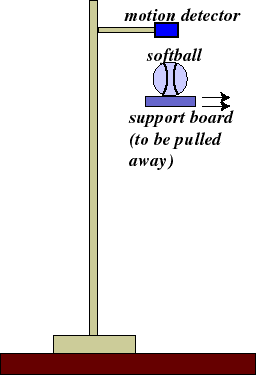 |
Question: What happens when the board is pulled out from under the softball?
Answer: Duh, let me guess.....
Question: So, HOW is the ball moving towards the ground?
Answer: The ball is accelerating towards the ground, as we observe its velocity to be changing at a constant rate over time.
Question: If the ball is accelerating, what is causing the acceleration?
Answer: The "force of gravity," the attraction between the Earth and the softball, is causing the ball to accelerate downwards.
Question: Is the "force of gravity" the same for lighter or heavier (less or more massive) objects of a similar shape?
| Try this experiment: |
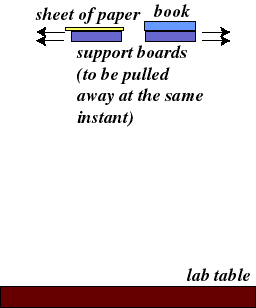 |
Answer: OK, so they both hit at the same time (after suitable modification). That means that they both accelerated in an identical manner, speeding up towards the table at the same rate. By Newton's II Law, the force of gravity acting on them is NOT the same. It varies in just the right way, according to their mass, so that they have the same acceleration.

 Definitions for speed, velocity, acceleration, force and mass in words.
Definitions for speed, velocity, acceleration, force and mass in words.
- Average speed of an object during a given time interval is the change in its position divided by the length of that time interval.
- Average velocity is the change in position (or displacement) divided by the change in time (or time elapsed).
- Displacement, velocity, acceleration and force all have magnitudes and directions.
- Acceleration is a measurement of both the change in speed and the change in direction of an object. Average acceleration is the change in velocity divided by the time interval.
- Experiments show that the acceleration of an object is directly proportional to the net force acting on it. This has several ramifications:
- As the net force applied on an object is increased, so is the object's acceleration. If the acceleration of an object is observed to decrease, then the net force acting on it must also have decreased in magnitude.
- The direction of the acceleration is the same as the direction of the net force.
- If no net force is exerted on an object, then its acceleration is zero (does this mean it velocity is necessarily zero?).
- Experiments also show that, for a given net force acting on an object, the acceleration of the object is inversely proportional to its mass.
- Thus, if the mass of an object is decreased, its acceleration will increase.
- Mass in this context is sometimes called inertia-- its resistant to change in motion. An object with greater inertia will resist change in motion (specifically, it will accelerate less) than a less massive object, all other things being equal.
 These two observations taken together can be summed up as Newton's Second Law: The acceleration of an object is proportional to the net force acting on it, and the constant of proportionality is the object's mass.
These two observations taken together can be summed up as Newton's Second Law: The acceleration of an object is proportional to the net force acting on it, and the constant of proportionality is the object's mass. 
 What if the net force is zero? Well, the object's acceleration will be zero, which means that its motion (velocity) will not change over time. This is called Newton's First Law. This does not mean, however, that the object must be at rest. If it already has some velocity, that velocity will stay the same.
What if the net force is zero? Well, the object's acceleration will be zero, which means that its motion (velocity) will not change over time. This is called Newton's First Law. This does not mean, however, that the object must be at rest. If it already has some velocity, that velocity will stay the same.
 Finally, there is Newton's Third Law, which is oftimes confusing. It says that if one object exerts a force on a second, the second must exert and equal and opposite on the first. If I sit on a skateboard and shoot a fire extinguisher, the force of the gas coming out of the fire extinguisher on the surrounding air causes a Third Law force on the extinguisher. As I am holding the extinguisher, it exerts a force on me. So....
Finally, there is Newton's Third Law, which is oftimes confusing. It says that if one object exerts a force on a second, the second must exert and equal and opposite on the first. If I sit on a skateboard and shoot a fire extinguisher, the force of the gas coming out of the fire extinguisher on the surrounding air causes a Third Law force on the extinguisher. As I am holding the extinguisher, it exerts a force on me. So....
-

 Work and Energy
Work and Energy
One definition used by physicists to describe the energy of simple objects is expressed in terms of work:
Energy is the capacity to do work.
The more work a simple object can do, the more energy it has. But what, specifically, is work? Scientists have a very particular definition for work-- a term that can mean many different things in every day language (e.g., I worked out, I got worked up or, we can work it out.). For simple objects, work is defined as the net force exerted on the object times the distance it is moved:
Work = Force x Displacement
In this case, the only important part of a force doing work is that part which points in or away from the direction of of displacement (remember, "displacement" is a distance and a direction).
- Consider the following simple experiment (Simple for telepathy (telekinetic?) man, maybe!):
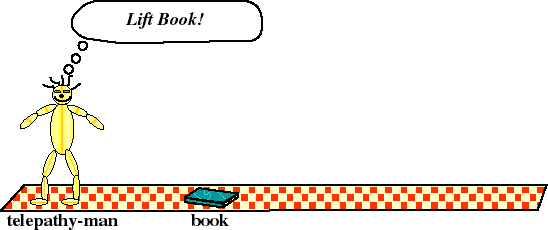
Let's analyze this "experiment" in terms of work.
- While tele-man is lifting the book he is doing work on the book (how many double-stuff ding-dongs need he eat to lift the book.....?). He is applying a force on the book over a distance of one meter. To make the book move upwards (from rest), he must apply a force greater than that of gravity, which pulls down on the book. The net force must be positive in the upwards direction.
- While holding the book still, tele-man is doing no work on the book. Sure he is telekinetically applying a force, but the book isn't moving in the direction of the force. Hence there is no force applied over a distance.... no work being done.
- When the book is moving at a constant velocity to the right tele-man is not doing work on the book. Sure, he may have to apply a force upwards to keep the book from dropping in response to the force of gravity, but that force is perpendicular to the direction the book is moving. The book is moving at a constant velocity to the right and, by Newton's First Law, the net force on it is zero. Hence the force in the direction of displacement is zero and no work is done.
- {Actually, to start the book moving and to stop it at the end does require application of some force in the direction of motion}
-
Now what about energy-- the capacity to do work?
Energy is a description of the capacity to do work, but what "has" energy and what does the work? In lifting the book, we can say that the book has gained energy. Energy is then a property of the book, just like its mass, velocity, etc.
However, the "capacity to do work" involves either work being done on the book, or work being done by the book.... work is something that requires interaction with something else. If we call the book a system, instead of simple object, then a system boundary surrounds the book. Energy describes what is inside the system boundary (the book), while the system (book) doing work or having work done on it requires crossing the system boundary.
Two types of energy: kinetic and potential
- Kinetic energy (KE) has been found to be proportional to an object's mass and the square of its velocity, as in:

{Even if an object has a negative velocity, it has positive kinetic energy.}
Kinetic energy is energy in motion. If a car is in motion, it has the capacity to do work... by running into something! So KE fits our definition for energy.
When a system gains potential energy (PE), it gains the potential to do work. In lifting a book, I do work on it. It gains potential energy. When I let go, this PE is converted into KE. For the book, this particular kind of potential energy is called gravitational potential energy (GPE):
- GPE = force times displacement = m g h (N-m)
-
- where m is the mass (kg), g is the (constant) acceleration of gravity at the Earth's surface (m/s2), and h is the height (m).
-

Telepathy-man loses his concentration.
-
 An Example: Hydroelectricity
An Example: Hydroelectricity

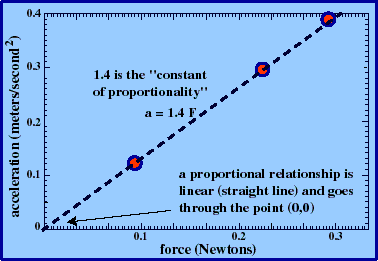
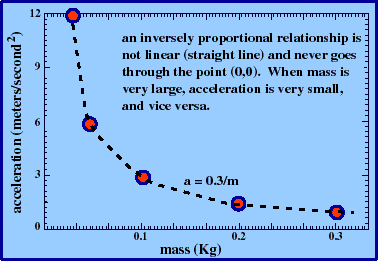


![]()

